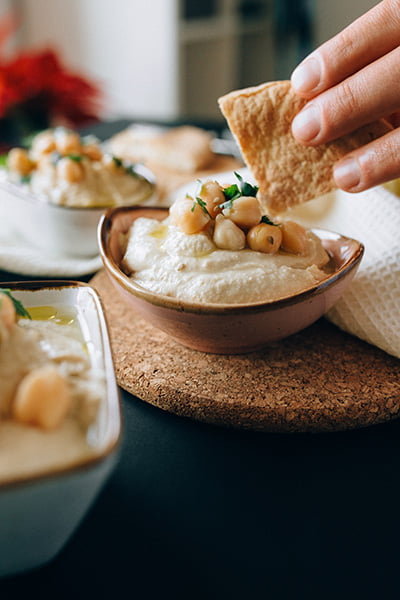For a considerable time, tahini has served as an essential ingredient in Middle Eastern and Mediterranean cuisines. Known for its creamy texture and adaptability, created by toasting sesame seeds and transforming them into a paste. With its rich nutty flavor and smooth texture, tahini adds depth and complexity to a wide range of dishes, from traditional hummus to delectable salad dressings and tantalizing desserts.
However, what happens when you find yourself craving that distinct nuttiness of tahini, only to realize you're out of stock or unable to consume sesame products due to allergies or dietary restrictions? Fear not, for the culinary world is brimming with exciting alternatives that can offer a comparable taste and texture, providing you with a delightful substitute for this beloved ingredient.
In this blog post, we will share the best tahini substitutes for tahini. Whether you're seeking a plant-based option, exploring new taste profiles, or adapting to dietary needs, we have you covered. From pantry staples of nut and seed butter to creative alternatives, we'll guide you through the best tahini substitutes that are readily available and will surely elevate your culinary creations.
What Is Tahini?
Tahini, also known as sesame butter, is a paste made from toasted ground sesame seeds or raw hulled sesame seeds. Recognized for its luscious creamy texture and distinctively nutty flavor, tahini stands as a fundamental component in Middle Eastern and Mediterranean cuisines. Tahini is widely used in a variety of dishes, both savory and sweet, and is a key component in popular recipes such as hummus, baba ganoush, and halva.
To create tahini, sesame seeds are first toasted and subsequently ground into a silky-smooth paste. Sometimes, the white sesame seeds are left untoasted for a milder flavor. The resulting paste can vary in consistency, ranging from thick to pourable, depending on personal preference or the desired application.
With its remarkable versatility, tahini can serve as an excellent foundation for a wide array of dressings, dips, sauces, and spreads. It adds depth and complexity to dishes, providing a creamy and slightly bitter undertone. Frequently, tahini is harmoniously combined with complementary ingredients like lemon juice, garlic, olive oil, or spices, resulting in delectable blends bursting with flavor.
Are Tahini Paste And Tahini Sauce The Same Thing?
The texture and flavor profile of tahini varies slightly from product to product. Those labeled as tahini paste are typically on the thicker side, and their thick, creamy texture makes it easier to spread a generous layer on a falafel sandwich, veggie wrap, or slice of toast. Jars and tins labeled as tahini sauce will have a bit more oil, giving them a thin, runny consistency that's perfect for stirring into desserts, sauces, and salad dressings. Either one will work just fine for making hummus.

Source: Pexels
What Does Tahini Taste Like?
Tahini has a distinct taste that can be described as a rich, nutty, and slightly bitter taste. The flavor profile of tahini is derived from the natural oils and compounds present in toasted sesame seeds.
When you taste tahini, you'll immediately notice its nutty undertones, reminiscent of roasted or toasted sesame seeds. This nuttiness is often described as earthy and robust, with a depth that adds complexity to dishes. The flavor is typically intense but not overpowering.
Alongside the nutty notes, tahini also carries a subtle bitterness. Tahini's distinctive taste profile stems from its inherent bitterness, which adds to its character. However, it is important to note that the bitterness is usually mild and well-balanced with the other flavors in a recipe.
The Best Tahini Substitutes
Now that you understand tahini better let's look at a few of the best alternatives to use if you're out.
Almond Butter
Almond butter is one of the best tahini substitutes, providing a similar nutty flavor and rich, creamy texture but lacking bitterness. And there's a good chance you've got a jar on hand! Stick with a smooth variety to keep the same creamy consistency, or use crunchy almond butter to add a little texture to cakes, brownies, and other baked goods.
To replace tahini, use an equal quantity of almond butter and make necessary adjustments to the remaining ingredients. Almond butter can be used in similar applications as tahini, such as dressings, sauces, and spreads.
Cashew Butter
Cashew butter, derived from ground cashews, can be used as a tahini substitute in certain recipes. This nut butter has a rich and creamy texture, similar to tahini, and a subtle sweetness. For a substitution, replace the tahini with an equal amount of cashew butter and adjust the rest of the ingredients appropriately. Cashew butter can be used in dressings, sauces, and dips and can add a delightful creaminess to desserts.
Cashew and almond butter exhibit a lusciously smooth and creamy texture, providing a gentle and nuanced flavor that harmonizes well with other ingredients without overshadowing them. Both options bring a nutty flavor profile to the table, making them ideal substitutes for tahini in milkshakes and desserts.
Peanut Butter
Creamy and natural peanut butter can serve as a suitable substitute for tahini. While it will impart a slightly different flavor profile, it works well in recipes that call for tahini. Use an equal amount of peanut butter as a substitute and adjust the other ingredients as needed. Peanut butter can be used in dressings, sauces, dips, and spreads, providing a creamy texture and delicious nuttiness.
Sunflower Seed Butter
Sunflower butter presents a fantastic choice for individuals with nut allergies or those seeking a seed-based alternative. Crafted from finely ground sunflower seeds, it boasts a smooth texture and a subtle, nutty taste akin to traditional nut butters. Similar to tahini, sunflower seed butter has a smooth and creamy consistency that works well in various recipes. It can be easily spread, blended, or incorporated into dressings, sauces, dips, and spreads.
Sunflower seed butter can be used in many ways, similar to tahini. It adds a creamy and slightly nutty element to dishes such as hummus, salad dressings, marinades, cookies, energy bars, and smoothies. In addition, it can be effortlessly spread on toast or employed as a dip for a delightful pairing with fruits and vegetables.
Sesame Seeds
When it comes to finding the best tahini substitute, what better option than the very ingredient from which tahini is derived? Sesame seeds are the key component of tahini.
One of the simplest ways to replicate the flavor and texture of tahini is by transforming sesame seeds into a smooth and creamy paste. To start, toast raw sesame seeds in a dry pan until they acquire a golden brown hue and release a delightful aroma. Once cooled, place them in a food processor or a blender and blend until a paste-like consistency is achieved. If desired, you can add a touch of neutral oil, such as sunflower or grapeseed oil, to enhance the creaminess. This homemade sesame seeds paste can be used as a one-to-one substitute for tahini in a variety of recipes.
Sesame Oil
While sesame oil shares a similar flavor profile with tahini, it is not an exact substitute due to its liquid consistency in some recipes. Sesame oil can be used as a flavoring agent in certain recipes, adding a nutty aroma, but it won't provide the same texture as tahini.
Sesame oil can emerge as a remarkable tahini substitute in some recipes as it captures the essence of sesame seeds while infusing dishes with their own unique character. Its concentrated nutty flavor, versatility, and ease of use make it a valuable ingredient in dressings, marinades, dips, and sauces. Because sesame oil has the tahini flavor but not the texture, Adding sesame oil to nut butters like sunflower seed butter or peanut butter can create the best tahini substitute.
Sesame oil can step in seamlessly in recipes that call for tahini as a key ingredient in dressings or sauces. Combine sesame oil with other complementary ingredients such as lemon juice, garlic, soy sauce, and honey to create a flavorful dressing or sauce for salads, grain bowls, or roasted vegetables.
Black Sesame Paste
Black sesame paste possesses a deep, rich, nutty flavor reminiscent of tahini. It is made from ground black sesame seeds and has a distinct profile with a slightly stronger roasted and earthy taste. This intense flavor adds complexity to dishes and can appeal to those who enjoy a deeper nuttiness.
Similar to tahini, black sesame paste has a creamy texture that lends itself well to a variety of culinary applications. It can be used as a smooth and silky base, enhancing the consistency and richness of recipes.
Black sesame paste can be used in both sweet and savory dishes, making it incredibly versatile. Sweet preparations add a delightful nutty undertone to desserts such as cookies, cakes, ice cream and Asian-inspired sweets like tangyuan or sesame balls. It can be used as a flavoring agent in dressings, sauces, dips, and marinades in savory dishes.
Greek Yogurt
If you are looking outside of nut or seed butter, Greek yogurt may just be what you want. While Greek yogurt won't work as a tahini substitute in most recipes, it can be a great tahini alternative as a last-minute swap in certain dips, dressings, and sauces. Stick with cold recipes, as yogurt tends to curdle in hot dishes. It won't bring the same flavor as tahini, so you'll probably want to add a few extra seasonings and spices to bring out the flavors of your dish.
Substitute tahini with Greek yogurt by using an equal amount and adjusting the other ingredients as needed. Greek yogurt works well in salad dressings, dips, and sauces, adding a creamy and tangy element to the dish.

Source: Pexels
How To Make Homemade Tahini
There is no better substitute for replacing tahini with homemade tahini! Creating homemade tahini is a simple procedure that only necessitates two ingredients: sesame seeds and oil. After you make your own tahini, you may never buy those store-bought tahini. Here's a simple step-by-step guide to making your own tahini at home:
Ingredients:
2 cups of hulled white sesame seeds
2-4 tablespoons of neutral-flavored oil (such as sunflower or grapeseed oil)
Instructions:
Heat a dry skillet or pan over medium heat and add the sesame seeds. Stir the seeds occasionally while toasting them until they turn a golden brown hue and release a pleasant fragrance. This process usually takes around 5-10 minutes, so it's crucial to monitor them closely to prevent any burning.
Remove the toasted seeds from the heat and let them cool completely. This step is crucial to avoid overheating the seeds when grinding them.
After allowing the sesame seeds to cool, transfer them to a food processor or a high-powered blender. Blend the sesame seeds on high speed, occasionally scraping down the sides until they break into a coarse powder.
While the food processor or blender is still running, slowly pour in the oil, beginning with 2 tablespoons. Keep blending until the mixture begins to smoothen and transform into a paste. If you desire a thinner consistency, you can add more oil, one tablespoon at a time, until you achieve the desired texture.
Stop the blender or food processor and check the consistency of the tahini. The desired outcome is a smooth, creamy, and effortlessly spreadable texture. If necessary, continue blending for a bit longer or incorporate a small amount of additional oil to attain the desired consistency.
Transfer the homemade tahini to an airtight container or jar. You can store it in the refrigerator for a duration of up to one month. Over time, the tahini may naturally separate, so stir it before use.
